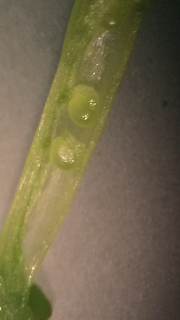Wednesday, February 15, 2017
Blog Post #7 -Annika Gordon
These are the flowers I picked to view under the microscope to look at the parts of a flower up close. Out of these flowers my partner, Christina, and I chose just one, but ended up needing several as we messed several times.
We made sure to pick flowers with larger anthers and pistils so that we would be able to see all the different parts more clearly than on small anthers and stigmas.
This image is of the anthers, which is part of the stamen, the male anatomy of a flower. It surrounds the pistils showing that this particular flower is both male and female, whereas some are just male or just female. The anthers grow at the end of stamen and consist of a sac which produces and releases pollen. This pollen is then picked up by birds, bees, and other insects on their bellies and feet when they land and transferred to the stigma of neighboring flowers.
This picture is of the the female anatomy of the flower, the carpel also know as the pistil, which contains the stigma, style, and ovary. The stigma is the sticky top which pollen grains attach to, and could be considered the landing zone for these pollen grains. The style is a long stalk which connects the stigma and ovary allowing the pollen that lands on the stigma to transfer sperm cells down into the ovary. In the ovary ovules are produced which when fertilized by sperm cells eventually become seed allowing for the flower species to continue living.
These are images of the inside of the pistil, more specifically the inside of the ovary which was cut in half so we could understand what was inside. The little round balls, more obvious in picture two, are unfertilized ovules. When they aren't underneath a microscope, they are smaller than even a grain of rice, but are the reason plants can reproduce. Without ovules the sperm cells from the pollen wouldn't have anything to fertilize, marking the end of that plant species life.
This image shows a very close up view of the pollen found on the anthers of our flowers which is used as a "capsule" for sperm cells. Pollen is grown on the anthers of plants and when picked up by wind or insects are transferred to the stigma of another plant. This picture is taken from a light microscope where we zoomed in so much you could see little ridges all over in, but the picture didn't capture them, so in reality pollen is actually smaller than even a grain of sand, yet it might just hold more importance.
Subscribe to:
Post Comments (Atom)






No comments:
Post a Comment